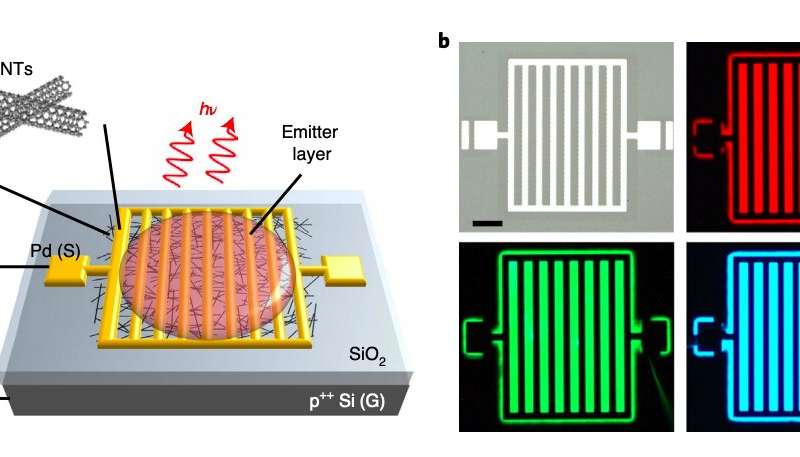September 8, 2020 feature

Electroluminescence (EL), electrically produced luminescence, is crucial to the operation of many electronic devices that are designed to emit light. EL can theoretically be achieved in devices with a variety of structures and made of different materials. However, to be electroluminescent, these devices need to have a number of core features that allow them to support specific light-emitting materials.
These core features have so far limited the range of materials that can be used to build electroluminescent devices. This ultimately prevented the development of devices that can emit light at a wide range of wavelengths.
Researchers at University of California Berkeley (UC Berkeley) have recently realized an electroluminescent device that can emit light from infrared to ultraviolet wavelengths. This new device, presented in a paper published in Nature Electronics, was built using carbon nanotubes (CNTs), large, cylindrical carbon-based structures that are often used to fabricate electronics.
"We show that a two-terminal device that uses an array of carbon nanotubes as the source contact can excite electroluminescence from various materials independent of their chemical composition," the researchers wrote in their paper.
Yingbo Zhao and his colleagues at UC Berkeley created a metal-oxide-semiconductor (MOS) capacitor structure that uses CNTs as a source contact. This structure enables carrier charge injection in a wide range of emissive materials, across different band alignments.
To create this structure, the researchers assembled semiconducting CNTs on a 50-nm SiO2/p++ Si substrate using a solution-processing technique. This enabled the formation of a continuous CNT network that can conduct electricity.
Compared to previously proposed approaches for creating electroluminescent devices, their design enables the use of a wide variety of light-emitting materials to achieve EL at the device level. In fact, it allows materials to be deposited directly on top of the source contact and is hence not limited by how well a device can process a given material. This results in the production of EL across a broader range of wavelengths.
"The device can produce EL from long-wave infrared (0.13 eV) to ultraviolet (3.3 eV) wavelengths, depending on the emitting material drop-casted on top of the nanotube array, and with onset voltages approaching the optical energy gap of the emitting material," the researchers explained in their paper.
The researchers tested the performance of the structure they designed in a series of simulations. They found that the CNT-based structure could enable the production of EL across a far wider range of wavelengths than what was achieved by most previously developed electroluminescent devices.
In the future, the device presented in this recent paper could be used to create advanced sensing and measuring tools for a wide range of applications. As part of their study, the researchers have demonstrated its potential as an instrument for EL spectroscopy and sensing, two applications that could be explored further in their next studies.
"We show that our device can be used to probe a chemical reaction in a liquid droplet via EL spectroscopy and can be used as an EL sensor for detecting organic vapors," the researchers wrote in their paper.
© 2020 Science X Network
Citation: A device that can produce electroluminescence from infrared to ultraviolet wavelengths (2020, September 8) retrieved 8 September 2020 from https://ift.tt/35bVw2C
This document is subject to copyright. Apart from any fair dealing for the purpose of private study or research, no part may be reproduced without the written permission. The content is provided for information purposes only.
"device" - Google News
September 08, 2020 at 08:30PM
https://ift.tt/35bVw2C
A device that can produce electroluminescence from infrared to ultraviolet wavelengths - Tech Xplore
"device" - Google News
https://ift.tt/2KSbrrl
https://ift.tt/2YsSbsy
Bagikan Berita Ini














0 Response to "A device that can produce electroluminescence from infrared to ultraviolet wavelengths - Tech Xplore"
Post a Comment